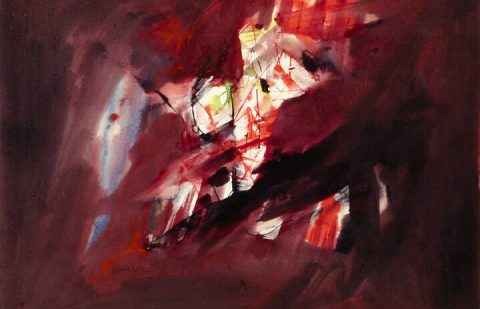This blog post comes from the desk of Senior Curator, Linda Jansma.
This is an unprecedented time in the history of Painters Eleven. Two of its members, Jack Bush and Jock Macdonald are simultaneously having major retrospective exhibitions. Jock Macdonald: Evolving Form, which debuted at the Vancouver Art Gallery last fall and has now just opened at the RMG runs concurrently with Jack Bush, an exhibition organized by and featured at the National Gallery of Canada.
As a co-curator of the Macdonald exhibition, I have been immersed in the project for three years and yesterday’s final touches on the installation were a satisfying experience. I’d seen the exhibition installation in Vancouver, and ours, because of the spaces we’re using, looks quite different. It’s interesting to see how work changes dependent on the height of galleries or the juxtaposition with different work—it’s the stuff that keeps curating fresh for me.
The experience I had with the Jack Bush exhibition was completely different. Two RMG works were included in the show and one of its principal curators, Sarah Stanners spent a good deal of time in our vault and with our archives. But that was extent of my knowledge of the exhibition.
The painting to greet visitors on entering the exhibition is a majestic sash painting—indeed, the entire first part of the exhibition concentrates on work that Bush did after 1961. These are paintings to which his international reputation is attributed. A room of his 1950s abstract expressionist work is one in which I felt particularly comfortable. He produced these paintings when he was a member of P11 and while they might not be considered as accomplished as his later work, I love the energy that spills from them. The majesty of these later works cannot however, be denied: expansive areas of colour, the brush strokes, unlike many other colour field painters, he allows his audience to see, as well as many of the works’ expansive sizes that envelope you when standing in front of them make for an incredible experience.

Portrait of Jack Bush at Park Gallery, 1958, The New Studio Photography, Gift of the Feheley Family, 2013
There are interesting similarities to the Bush and Macdonald stories. The NGC retrospective highlights the importance of Bush’s relationship with New York critic Clement Greenberg (although puts to rest the myth that Greenberg all but guided Bush’s brush), while the Macdonald exhibition shines a light on the relationship he had with British Surrealists Dr. Grace Pailthorpe and Reuben Mednikoff. The Bush family gave unprecedented access to their father’s diaries giving a personal voice to the project. The Macdonald project saw the inclusion of both a previously unknown diary that he kept while roughing it with his family in Nootka Sound, as well as close to forty letters that he’d written to his mentors Pailthorpe and Mednikoff. These primary sources have enriched both projects.
As a curator who has worked with a collection by members of Painters Eleven for many years, seeing both of these exhibitions is particularly satisfying for me. It also makes me realize how much has yet to be done: as a start, Ray Mead or Walter Yarwood retrospectives anyone?



